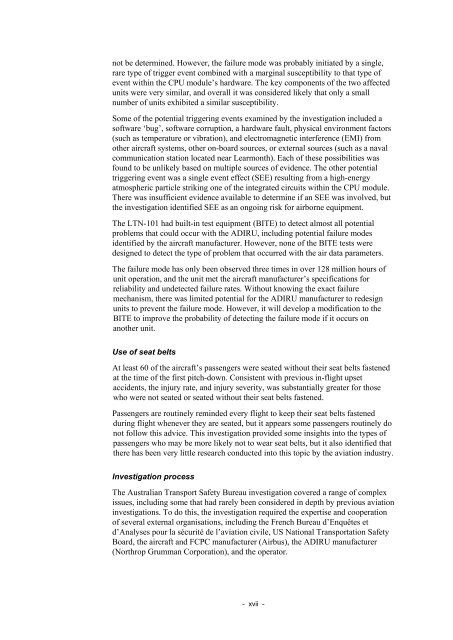In-flight upset - 154 km west of Learmonth, WA, 7 October 2008,
In-flight upset - 154 km west of Learmonth, WA, 7 October 2008,
In-flight upset - 154 km west of Learmonth, WA, 7 October 2008,
- No tags were found...
You also want an ePaper? Increase the reach of your titles
YUMPU automatically turns print PDFs into web optimized ePapers that Google loves.
not be determined. However, the failure mode was probably initiated by a single,rare type <strong>of</strong> trigger event combined with a marginal susceptibility to that type <strong>of</strong>event within the CPU module’s hardware. The key components <strong>of</strong> the two affectedunits were very similar, and overall it was considered likely that only a smallnumber <strong>of</strong> units exhibited a similar susceptibility.Some <strong>of</strong> the potential triggering events examined by the investigation included as<strong>of</strong>tware ‘bug’, s<strong>of</strong>tware corruption, a hardware fault, physical environment factors(such as temperature or vibration), and electromagnetic interference (EMI) fromother aircraft systems, other on-board sources, or external sources (such as a navalcommunication station located near <strong>Learmonth</strong>). Each <strong>of</strong> these possibilities wasfound to be unlikely based on multiple sources <strong>of</strong> evidence. The other potentialtriggering event was a single event effect (SEE) resulting from a high-energyatmospheric particle striking one <strong>of</strong> the integrated circuits within the CPU module.There was insufficient evidence available to determine if an SEE was involved, butthe investigation identified SEE as an ongoing risk for airborne equipment.The LTN-101 had built-in test equipment (BITE) to detect almost all potentialproblems that could occur with the ADIRU, including potential failure modesidentified by the aircraft manufacturer. However, none <strong>of</strong> the BITE tests weredesigned to detect the type <strong>of</strong> problem that occurred with the air data parameters.The failure mode has only been observed three times in over 128 million hours <strong>of</strong>unit operation, and the unit met the aircraft manufacturer’s specifications forreliability and undetected failure rates. Without knowing the exact failuremechanism, there was limited potential for the ADIRU manufacturer to redesignunits to prevent the failure mode. However, it will develop a modification to theBITE to improve the probability <strong>of</strong> detecting the failure mode if it occurs onanother unit.Use <strong>of</strong> seat beltsAt least 60 <strong>of</strong> the aircraft’s passengers were seated without their seat belts fastenedat the time <strong>of</strong> the first pitch-down. Consistent with previous in-<strong>flight</strong> <strong>upset</strong>accidents, the injury rate, and injury severity, was substantially greater for thosewho were not seated or seated without their seat belts fastened.Passengers are routinely reminded every <strong>flight</strong> to keep their seat belts fastenedduring <strong>flight</strong> whenever they are seated, but it appears some passengers routinely donot follow this advice. This investigation provided some insights into the types <strong>of</strong>passengers who may be more likely not to wear seat belts, but it also identified thatthere has been very little research conducted into this topic by the aviation industry.<strong>In</strong>vestigation processThe Australian Transport Safety Bureau investigation covered a range <strong>of</strong> complexissues, including some that had rarely been considered in depth by previous aviationinvestigations. To do this, the investigation required the expertise and cooperation<strong>of</strong> several external organisations, including the French Bureau d’Enquêtes etd’Analyses pour la sécurité de l’aviation civile, US National Transportation SafetyBoard, the aircraft and FCPC manufacturer (Airbus), the ADIRU manufacturer(Northrop Grumman Corporation), and the operator.- xvii -



